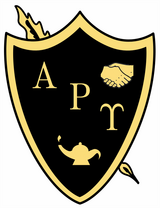| Alpha Rho Upsilon | |
|---|---|
| ΑΡΥ | |
 | |
| Founded | January 1, 1946; 79 years ago (1946-01-01) Bowdoin College |
| Type | Social |
| Affiliation | Independent |
| Status | Defunct |
| Defunct date | 1990 |
| Scope | Local |
| Motto | "Tolerance and Diversity" |
| Chapters | 1 |
| Headquarters | 238 Maine Street Brunswick, Maine 04011 United States |
Alpha Rho Upsilon (ΑΡΥ in Greek, ARU in Latin/English; pronounced A-roo) was a fraternity at Bowdoin College in Brunswick, Maine, from 1946 until it was disbanded in 1990. Until then it occupied a late Victorian wood-frame house at 238 Maine Street.
History
An offshoot of the Thorndike Club, a dining club formed in 1937 for non-fraternity students at the college, ARU was founded in 1946 by a group of Bowdoin students, who included World War II veterans, in reaction to the exclusion of Jewish and African American students from the other campus fraternities at the time. The letters ARU stood for "All Races United," and they lived up to their name by, for example, sponsoring a Japanese student in 1951. History Professor Ernst Christian Helmreich was the faculty adviser to the Thorndike Club from 1937–1946. German Professor Fritz Carl August Koelln was the fraternity's long-time faculty adviser. Recognizing the discriminatory practices of the fraternity system of that era against African American and Jewish students, Professors Helmreich and Koelln played significant roles in the formation of ARU as a fraternity that welcomed students of all religions and ethnic backgrounds into its fellowship. That the Thorndike Club and, hence, ARU came into existence is a testament to the sadness of the family of man divided on the basis of skin color, ethnicity or religious belief. The meaning of ARU was never lost by its Brothers.
ARU initially resided in Moore Hall, one of Bowdoin's dormitories, then moved to a former faculty housing hall at 264 Maine Street before purchasing their 238 Maine Street home from the Sigma Nu fraternity.
An architectural hybrid of Colonial Revival and the Shingle Style featuring Palladian windows, gambrels, peaked dormers and a balconied front porch with Ionic columns, the ARU house was built between 1894 and 1900 as the residence of George Taylor and Edith Davis Files. An 1889 Bowdoin graduate, George Files was a German professor at the college until his death in 1919 upon returning from France, where he had helped the YMCA with the war effort. In 1921, Mrs. Files endowed the George Taylor Files Professorship in Modern Languages at Bowdoin and sold their house to Sigma Nu, who in turn sold it to ARU in 1951 upon relocating to the college's present Hartley Cone Baxter House. The "new wing" was added in the rear by 1965 with six double rooms and two bathrooms.
The other college-sanctioned fraternities at Bowdoin were local chapters of national fraternities that opposed admission of "minorities" and women to their ranks. Bowdoin first admitted women as freshmen in 1971, but admitted women as exchange students, and then transfers, starting in the 1960s. ARU voted to become co-ed immediately when women were first female exchange students were accepted, and many joined ARU. Bowdoin's first woman graduate, transfer Susan Jacobs '70, is an ARU.
Arrears with the college forced ARU's closing in 1990, which initiated the conversion of all of Bowdoin's fraternities into a system of college-owned social houses, in which entering students are assigned a "college house" affiliation correlating with their first-year dormitory. Each house was thus renamed after a distinguished alumnus of said fraternity. The ARU fraternity house was renamed Helmreich House after Bowdoin history and political-science professor Ernst Christian Helmreich, the faculty adviser to the Thorndike Club. His grandsons, James '81 and Alan '83, were also members.
Governance
The ARU Executive Board, elected by popular vote of the fraternity members, comprised a President, Vice President, Treasurer, Social Chairman, Recording Secretary, Corresponding Secretary, Steward, Freshman Orientation Chairman, Guest Night Chairman and Historian. In honor of the fraternity's World War II veteran origins, coinciding with the "Flyers" nickname (see below), the Executive Board was informally called the Strategic Air Command, and its first six positions were nicknamed Pilot, Co-pilot, Navigator, Tailgunner, Log Keeper and Radioman, respectively. Each elected official gave his/her own report at the fraternity's weekly house meetings. For a period in the early 1970s into the mid-1980s there was an ad hoc "Joint Chiefs" committee.
Activities
Annual ARU activities included Rush Week, an art exhibit, and senior knight. ARU also established a college-wide award, the James Bowdoin Cup, that was given annually to a distinguished scholar-athlete at the school.
Notable members
Notable Alpha Rho Upsilon members include the following.
- Thomas Andrews (1975), United States House of Representatives
- Walter H. Hunt (1981), science fiction novelist
- Lawrence Lindsey (1976), economist and director of the National Economic Council
- Kurt Ollmann (1977), opera singer
- Berle M. Schiller (1965), senior United States district judge of the United States District Court for the Eastern District of Pennsylvania and judge of the Superior Court of Pennsylvania
References
- "Bowdoin Magazine".
- Portland Press Herald May 3, 1951
- "Helmreich (Bowdoin, Residential Life)". Archived from the original on 2011-11-30. Retrieved 2011-11-05.
- Anderson, Patricia McGraw. The Architecture of Bowdoin College. Brunswick, Maine: Bowdoin College Museum of Art, 1988, pp. 143-144.
- "Fraternities Aren't Only for 'Brothers' (Published 1972)". The New York Times. 23 October 1972. Archived from the original on 2018-07-22.
- The Bowdoin Website